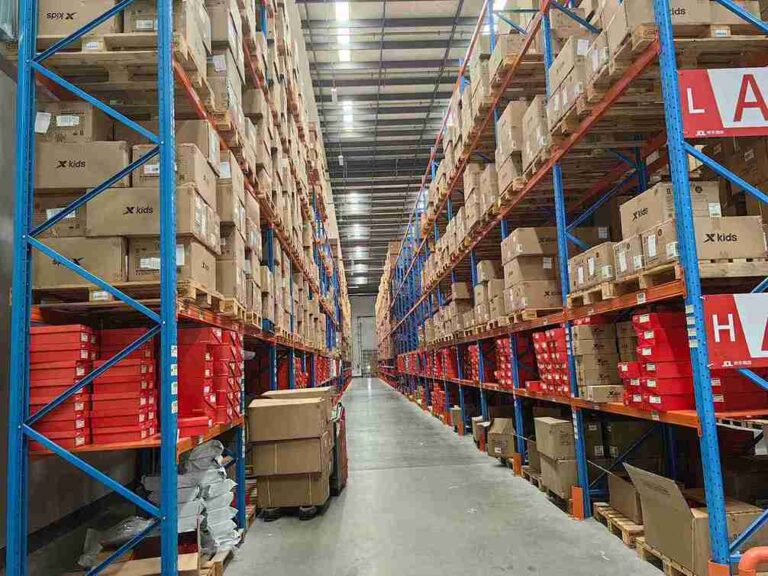📐 "First 50 Enterprise Queries Get Custom 3D Warehouse Design" Plan

Introduction: The Power of Racking Layout Optimization
Every high-performing warehouse relies on racking layout optimization tips to maximize space, streamline operations, and reduce costs. Whether managing pallet racking, selective racking, or cantilever systems, an optimized layout ensures faster picking, safer workflows, and better inventory control.
This guide delivers actionable racking layout optimization tips to transform any warehouse into a well-organized, high-efficiency storage facility. By following these five strategic steps, businesses can achieve:
✔ 30-50% more storage capacity
✔ 20% faster order fulfillment
✔ Reduced forklift travel time
✔ Lower risk of workplace accidents
Let’s dive into the most effective racking layout optimization tips used by industry leaders.

Step 1: Conduct a Thorough Warehouse Audit
Why Auditing is the First Step in Racking Layout Optimization
Before making changes, warehouse managers must analyze their current setup. A comprehensive audit identifies inefficiencies, such as:
- Underutilized vertical space
- Congested picking zones
- Inefficient forklift paths
Key Metrics for Racking Layout Optimization
- Storage Density – Are racks packed too tightly or too loosely?
- Pick Path Efficiency – How many steps do workers take per order?
- Damage Rates – Are collisions or overloading causing rack damage?
Tools to Improve Racking Layout Optimization
- 3D Warehouse Modeling Software (e.g., AutoCAD, SketchUp)
- Heat Mapping for Foot Traffic Analysis
- RFID & Barcode Scanning for Inventory Tracking
Pro Tip: Use racking layout optimization tips from the Warehouse Education and Research Council (WERC) to benchmark performance.
Step 2: Select the Best Racking System for Your Needs
How the Right Racking System Enhances Layout Optimization
Not all racking systems work for every warehouse. The best choice depends on:
✅ Inventory type (pallets, long goods, small items)
✅ Turnover rate (fast vs. slow-moving stock)
✅ Forklift accessibility (narrow aisle vs. wide aisle needs)
Top Racking Systems for Layout Optimization
1. Selective Pallet Racking – Best for High SKU Variety
- Optimization Benefit: Direct access to every pallet
- Best For: Warehouses with frequent manual picking
2. Drive-In/Drive-Through Racking – Ideal for High-Density Storage
- Optimization Benefit: Maximizes space for bulk storage
- Best For: FIFO/LIFO inventory (e.g., food, beverages)
3. Push-Back Racking – Perfect for Medium-Density Storage
- Optimization Benefit: Gravity-fed system reduces forklift travel
- Best For: Warehouses with multiple pallets per SKU
4. Cantilever Racking – Optimal for Long, Bulky Items
- Optimization Benefit: No vertical obstructions
- Best For: Storing pipes, lumber, furniture
Pro Tip: Combine different systems (e.g., selective racking for fast movers + drive-in for bulk storage) for maximum racking layout optimization.
Step 3: Master Slotting Strategies for Faster Operations
Why Slotting is Critical in Racking Layout Optimization
Slotting means placing products where they can be picked and replenished most efficiently. Poor slotting leads to:
❌ Excessive travel time
❌ Higher labor costs
❌ Increased picking errors
Best Slotting Techniques for Racking Optimization
1. ABC Analysis – Prioritize High-Demand Items
- A-items (20% of SKUs, 80% of picks) → Place near shipping docks
- B-items (30% of SKUs, 15% of picks) → Mid-level racks
- C-items (50% of SKUs, 5% of picks) → Higher or deeper storage
2. Golden Zone Placement – Speed Up Picking
- Store fast-moving items between knee and shoulder height
- Reduces bending and reaching, improving ergonomics
3. Family Grouping – Cluster Related Items
- Store frequently ordered together items in the same aisle
- Example: Batteries + flashlights, paint + brushes
Pro Tip: Use AI-powered WMS (like Oracle or SAP) for dynamic slotting adjustments based on real-time demand.
Step 4: Optimize Aisle Width & Traffic Flow
How Aisle Design Impacts Racking Layout Optimization
- Narrow Aisles (8-10 ft) → Require narrow-aisle forklifts but boost storage density
- Wide Aisles (12-14 ft) → Allow standard forklifts but waste space
Traffic Flow Best Practices
✔ One-Way Aisles → Prevent forklift congestion
✔ Cross-Docking Zones → Speed up inbound/outbound logistics
✔ Pedestrian Walkways → Separate workers from forklifts
Pro Tip: Follow Lean Warehouse 5S Methodology (Sort, Set in Order, Shine, Standardize, Sustain) for continuous racking layout optimization.
Step 5: Implement Safety & Maintenance Best Practices
How Safety Enhances Racking Layout Optimization
A poorly maintained racking system leads to:
⚠ Collapsed racks
⚠ Forklift accidents
⚠ OSHA violations & fines
Top Safety Tips for Racking Optimization
- Never exceed load capacity (check manufacturer specs)
- Inspect racks monthly for bent beams or loose bolts
- Use rack protectors to prevent forklift collisions
Preventative Maintenance Checklist
🔧 Lubricate moving parts (for push-back & drive-in racks)
🔧 Check floor levelness (uneven floors cause instability)
🔧 Train staff on proper loading techniques
Pro Tip: Follow RMI (Rack Manufacturers Institute) guidelines for compliance.
Conclusion: Transform Your Warehouse with Racking Layout Optimization
By applying these racking layout optimization tips, warehouses can:
🚀 Boost storage capacity by 30-50%
🚀 Cut order fulfillment time by 20%
🚀 Reduce operational costs
🚀 Improve workplace safety
Start optimizing today—audit your layout, choose the right racking system, refine slotting, streamline aisles, and enforce safety protocols.
For expert assistance, consult rack design specialists or explore warehouse automation solutions.
Frequently Asked Questions (FAQs)
1. How often should we reassess our racking layout?
Answer: Every 6-12 months, or after major inventory changes.
2. What’s the best racking system for small warehouses?
Answer: Selective pallet racking (flexible & space-efficient).
3. How can we increase storage without compromising safety?
Answer: Use push-back or drive-in racking with proper load limits.
4. What’s the biggest mistake in racking layouts?
Answer: Ignoring vertical space—many warehouses waste overhead storage.
5. How do we ensure OSHA compliance?
Answer: Follow RMI standards and conduct professional inspections.




